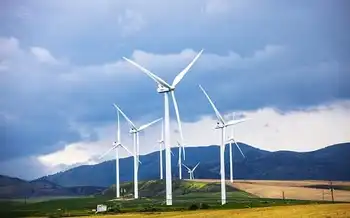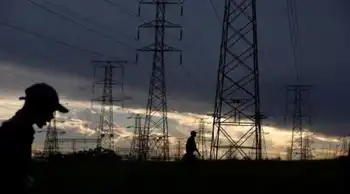Copenhagen eyes a clean, green future
By Toronto Star
Arc Flash Training - CSA Z462 Electrical Safety
Our customized live online or in‑person group training can be delivered to your staff at your location.

- Live Online
- 6 hours Instructor-led
- Group Training Available
And here on the ground, a city where cyclists outnumber motorists during the downtown commute on close to 400 kilometres of dedicated lanes so safe that the vast majority don't even bother wearing helmets, which aren't mandatory anyway.
At first glance, Copenhagen is everything the brochure says: a hand-shaped city where each finger of suburb is separated by green space and in each fingerbone, a transit corridor of trains and buses, car and bike lanes to the central palm, where many of the globe's deepest environmental thinkers can be found.
Or so it all seems, through North American eyes.
Ask the Danes, and they will tell you yes, they are rightly proud of their great green strides – especially the fact that this country of just 5.4 million leads in the delicate art of harnessing wind.
How did the Danish windmill come to rule the world? It all dates back to the shower-with-a-friend 1970s, when the OPEC oil crisis and a broad national reluctance to go nuclear sent Denmark on a quest for better energy answers.
From those first small land-mounted experimental turbines to the latest generation of multi-megawatt offshore behemoths, the modern, efficient Danish turbine stands today at the forefront of the emerging green economy – very nearly, but not quite, at cost-per-unit par with fossil fuels.
In total, Denmark drives 40 per cent of the global wind market, and its largest manufacturer, Vestas Wind Systems, commands a workforce of 15,000.
Ironically, while Vestas crews are in demand on five continents, the next generation of wind farms has been embarrassingly slow to take root in Denmark. Since 2004, the Danes have added little of their own product, compared to more than 2,500 megawatts of new wind production between 1996-2003.
The disappointing reason is a familiar four-letter word: coal.
"The brochure tells you that 16 per cent of our energy comes from renewable sources. This is true. What the brochure doesn't say is that a huge and increasing amount of the rest of our energy comes from coal," says Tarjei Haaland, who has monitored climate and energy issues for Greenpeace Denmark since 1992.
"We were doing great things until 2001, when a new government arrived with a different approach. Since then, many of us feel we've been squandering our advantage. We saw reduced government support for renewables in favour of a shift back to coal. So now the sad fact is our carbon emissions are increasing. This is the dirty Denmark they don't put on the poster."
The Danish government appears to have turned a corner, however, striking an agreement last month that will see at least a partial return to the progressive policies of carbon reduction. At the very least, the move is the politically expedient thing to do, given that Copenhagen is scheduled in late 2009 to host the UN Summit on Climate Change, where participants hope to seal a robust global action plan.
But even as climate campaigners chide their national government's recalcitrance, most offer high praise for Copenhagen's municipal leadership, which has set itself an ambitious goal for 2015 to become what it calls the world's "Eco-Metropole" – the cleanest, greenest, lowest-emitting city on the planet.
"The things we've already achieved show us that Copenhagen doesn't need national legislation to go even further. We can do most of this on our own," said Klaus Bondam, the city's mayor of technology and the environment. "Cleaning up our harbour so that you can swim and catch cod fish, enhancing our cycling network to where it is today, becoming one of the first in the world to convert the wasted heat of electrical generation into heat for our homes – Copenhagen has done all this. And now we lead Europe. By 2015, we'll lead the world."
Among the city's goals is a plan to raise to 50 per cent the number of downtown commuters arriving by bicycle. The number seems otherworldly, until you consider that bikes comprise 36 per cent of downtown traffic, compared to only 27 per cent private automobiles.
To fully comprehend how such numbers are possible, the Toronto Star sought a history lesson from Dansk Cyklist Forbund – the Federation of Danish Cyclists – an organization launched in 1905 when the pressing issue of the day was punctures resulting from horseshoe nails littered along Copenhagen's network of horse paths.
"Here in Copenhagen, riding a bike is like wearing shoes," said DCF's Allan Carstensen. "It's normal. It's easy. It's convenient. People ride in their work clothes. And even the people in cars, the chances are they have a bike at home that they use regularly to run errands in the neighbourhood."
The sheer flatness of the city helps, as does the lack of weather extremes – even during a dusting of snow flurries this week, the hardier pedalers were out. Best of all, Copenhagen comes in condensed proportions, with a population of just 1.5 million people, most of whom field modest five-click commutes that would be the envy of many Torontonians.
Still, it is a wonder to behold the choreography of Copenhagen in full pedal regalia, with a rush hour that includes cyclists from 8 to 80 flowing at a brisk average of 16 km/h. The dedicated lanes take much of the worry out of encounters with cars, but corners remain tricky, as this is where cyclists sometimes meet motorized metal.
That Copenhagen's zero-carbon cycling culture fits perfectly with the times is sheer serendipity, for it is merely an enhanced version of a lifestyle that began a century ago.
"Most of our lifestyle is historic – a result of wars that taxed our resources and made us worry about being self-sufficient," said political scientist Bjorn Lomborg, one of Copenhagen's most provocative environmental thinkers.
"We grew out of medieval towns that were built before anyone thought of cars. The cycle culture was an extension of that. But make no mistake, there are trade-offs. We deliberately made our cities more compact. And the price is we live in smaller homes than most Canadians, we have fewer gardens and backyards, our kids have slightly fewer places to have fun in."
Mayor Bondam, on a major branding mission for Copenhagen, unabashedly holds out the welcome mat for Toronto officials to come hunting for inspiration. Harbour rehabilitation, waste management, cycling ideas, wind farms, the combined heat and generation plant at Avedore that fires on a variety of fuels, including straw and wood pellets – Copenhagen is happy to show its hand.
"We know Copenhagen is a small city. But we see our role in the future global community as a sort of model city that experiments constantly with environmental projects, so that hopefully bigger cities like Toronto can draw on our experience," said Bondam.
"It's not a question of bragging. We just want to show some political leadership, by being a city that will dedicate itself to these ideals by striving for and sharing more efficient energy solutions."
Environmental critic Lomborg doesn't question Copenhagen's ability to find solutions. But he is becoming famous for his scintillating critique of the world's obsession with carbon reduction, which he reckons is precisely the wrong response to the right problem.
"The crucial problem with the climate change debate is actually very similar to the bike helmet debate, because the obvious solutions don't ultimately do the most good," said Lomborg, who heads the Copenhagen Consensus Centre.
"You think, `Head injuries bad, everyone must wear helmets.' But then you lose a bunch of the riders who hate wearing helmets and they need much more expensive health care in the end."
Similarly, said Lomborg, the climate change debate seems now almost certain to be aiming for a batch of new carbon-reduction promises at next year's UN Summit in Copenhagen. A revival of the kind of goals that were set in 1992 at the Earth Summit in Rio ("which failed," said Lomborg) and later, Kyoto ("failed again.").
"The world failed twice. And now it is talking about coming to Copenhagen with promises to spend the equivalent of 25 to 50 per cent of each country's health budget on reducing carbon emissions."
Instead, Lomborg is a relentless advocate for directing those vast resources into a dramatic acceleration of global research and development in search of the answer – or, more likely, the range of answers – to future energy needs.
"Somewhere in the next 50 to 100 years – possibly much sooner – we will find the answer to climate change," he said.
Lomborg can't resist one especially tantalizing afterthought. He posits the notion that 100 years from now, under a best-case scenario, Toronto, and not Copenhagen, could end up being the dream city.
"Imagine 100 years from now that we have abundant, free, clean energy that is no longer scarce. Copenhagen will still be here biking around. But I'm not really sure we'll be so happy with our small, condensed city, so focused on conserving resources that are no longer scarce.
"Toronto will be there in your bigger houses and yards, Copenhagen will be here in our tiny apartments. Maybe you will be the winners. And we will be envious of you."











